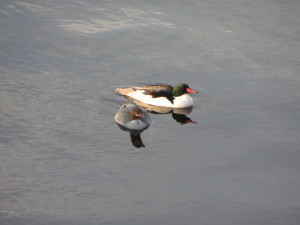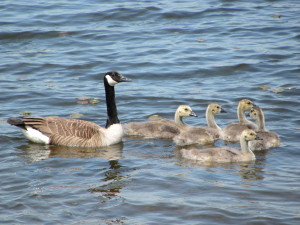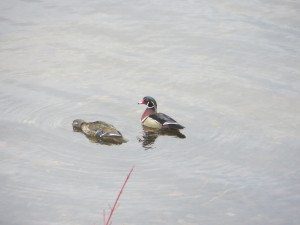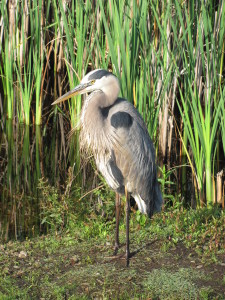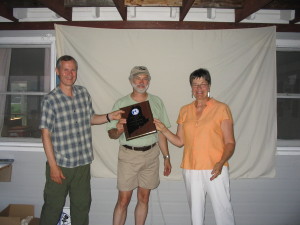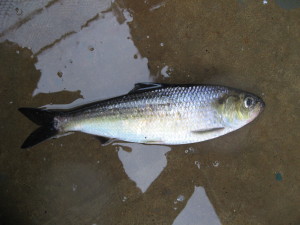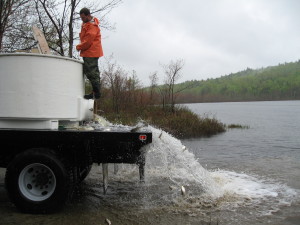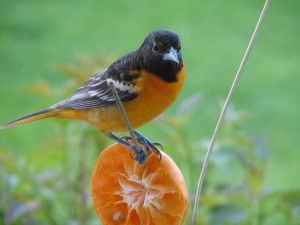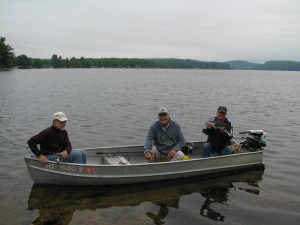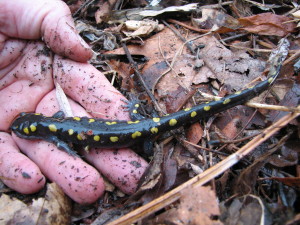by Anne Goorhuis
As property owners living adjacent or close to the lake, we are all interested in maintaining a clean, algae-free Taylor Pond for our own enjoyment and to maintain the property values of our homes. What follows is a glossary of must-know terms of the eco-speak of lakeside property care.
THE COMMON RAINDROP – The common raindrop is public enemy number one to maintaining water quality because of the following: Rain carries soil down to the lake. Soil binds with phosphorous and carries it to the lake. High levels of phosphorous in a lake create algal blooms. An algae bloom lowers property values and lessens our personal enjoyment of the lake. See Erosion Control, Storm Water, Open Box Culverts, Phosphorous
PHOSPHOROUS – The measurement of phosphorous is considered to be the most reliable measure of a pond’s capacity to have an algal bloom. Thus any use of fertilizer (the most common way ponds get contaminated) should be judiciously weighed. Test your soil via the Maine Extension Service, and amend only the recommended factors. When reading a bag of fertilizer, such as 15 – 10 – 12, the middle number stands for Phosphorous. Indiscriminate use of 20-20-20 fertilizer can be deadly to a lake! If a soil test shows you need soil amendments, use slow-release products like bone meal, bloodmeal, or cottonseed meal. Compost is the perfect amendment because it increases the soil’s capacity to hold water, yet keeps soil workable. By the way, ponds with phosphorous levels below 15 are considered to be unlikely to have an algal bloom. Taylor Pond’s mean (since 1975) is 11. Kudos to us! Let’s keep up the good work!
See The Common Raindrop, Storm Water, Erosion Control
STORM WATER – Lengthy rains and down pours create storm water, i.e. precipitation that cannot be absorbed immediately by the soil. How a property within a watershed handles storm water has a direct bearing on lake water quality. Storm water that creates ruts in dirt roads only to be directed the shortest way possible to the lake carries loads of unwanted phosphorous into the lake. Storm water that is diverted off the road into vegetated areas or catch basins, allows the soil to settle out and the water to filter before entering the lake. Storm water coming off rooftops and driveways carries similar implications. See Open Top Culverts, Level Lip Spreaders, Rain Gardens, Buffer Strips, Vegetated Buffers
EROSION CONTROL – Erosion control methods allow storm water to be diverted to vegetated buffers or holding areas. This cuts back on the quantity of soil displaced and keeps what has been displaced out of the lake. The goal of erosion control is to allow storm water to be either spread out, filtered out, or absorbed. All three goals keep the common raindrop from carrying phosphorous into the lake. See Open Top Culverts, Level-lip Spreaders, Vegetated Buffers, Rain Gardens
RAIN GARDENS – Rain gardens are natural or man-made depressions in the lawn area planted with attractive plants. Water puddles here temporarily during times of rain. To the lake, the advantage of a rain garden is that the roots of the plants absorb more water than mere grass. To the homeowner, the advantage is more attractive landscaping surrounding the home. Email the lake association if you would like a photocopy of example rain garden layouts. See Erosion Control, The Common Raindrop
OPEN TOP CULVERTS – Open top culverts are the opposite of a speed bump; they are dips in a dirt road that funnel storm water off the road into vegetated areas to be absorbed or filtered. Normally constructed out of pressure treated wood, they are open at the top, and do require emptying once dirt settles into them. This drawback is counterbalanced by the fact that open top culverts slow down the formation of unwanted ruts and potholes. To view an open top culvert, travel West Shore Drive, Waterview Drive, Willard Road or the dirt portion of Taywood Road. See Erosion Control
LEVEL-LIP SPREADER – A level-lip spreader is essentially a catch basin with one important difference. All rainwater flows down hill and some storms are so lengthy or intense that a ditch will fill up before a storm is over. A level-lip spreader allows fast-running, soil-containing rain water to be diverted into it, creating a large, deep puddle. Now that the water has slowed its speed, the dirt can settle to the bottom of the level-lip spreader, and cleaner water can flow out of it over a 6 foot to 12 foot lip (which is level) into a vegetated buffer and finally into the lake. A wide band of slow flowing water is always preferable to a narrow band of quickly flowing water when it comes to lake water quality. The water in the level-lip spreader is temporary, drying after a few days. Knock on the door of 97 Taywood Rd. for a tour of the level-lip spreader on the author’s property. See Vegetated Buffer, Erosion Control
VEGETATED BUFFER – Ideally, the lakefront home will have three tiers of vegetation at the water’s edge; mature trees, undergrowth of younger trees or bushes and the lowest level consisting of grasses, ground covers or low care perennials such as day lilies, hostas and sedum. The more vegetation on the edge of the lake or near the end of an open top culvert the better, because vegetation encourages the absorption of water from the soil and the plants can use the phosphorous deposited there during times of storm water. A “no-mow” policy is recommended for the first twenty feet of land along the length of the water’s edge, but an 8’ or 10’ buffer is also a great start. This is also called a buffer strip. On our property, when I decided to no longer mow at the water’s edge, I planted a row of low-care, long blooming day lilies to separate the “untidy” long grasses from the lawn chair area. See Erosion Control, Level-lip Spreader, Open Top Culvert, Phosphorous
NONPOINT SOURCE POLLUTION – To understand this term, consider the opposite: If you can stand and point to a source of pollution such as a factory, farm or oil spill it is not nonpoint source pollution. Nonpoint source pollution is all the little stuff of modern living that does, in fact, add up and negatively affect the quality of our lake. Examples include: rain coursing down our gutters and washing out the landing, the dirt churned up with rainwater in the ruts of dirt roads, home construction without the proper soil containment devices, the residual oil left in the lake from boat motors, the dust and tree dirt from our driveways. These all have an effect. “Do we just stop living?” you may ask in frustration. “No!” but we can choose to handle these minor sources of pollution as responsibly as possible.
Each property owner on or off the lake can allow the natural hollows in the lay of the land to remain, or create artificial ones via a rain garden. Each property owner along a dirt road can choose to handle the storm water responsibly on his or her section. Each lakefront owner can choose not to mow 8 feet next to the lake and to maintain their boats properly. Knock on the door of 104 Terrace Rd. for a tour of how one homeowner manages the rain water off her section of dirt road.
In conclusion, I hope some of you will hop in your car and tour some of the features mentioned above. Or take some affirmative action, and sign up for the two hour LakeSmart presentation to educate yourself. Lake living is worth an investment of time and effort! Collectively a difference can be made!
